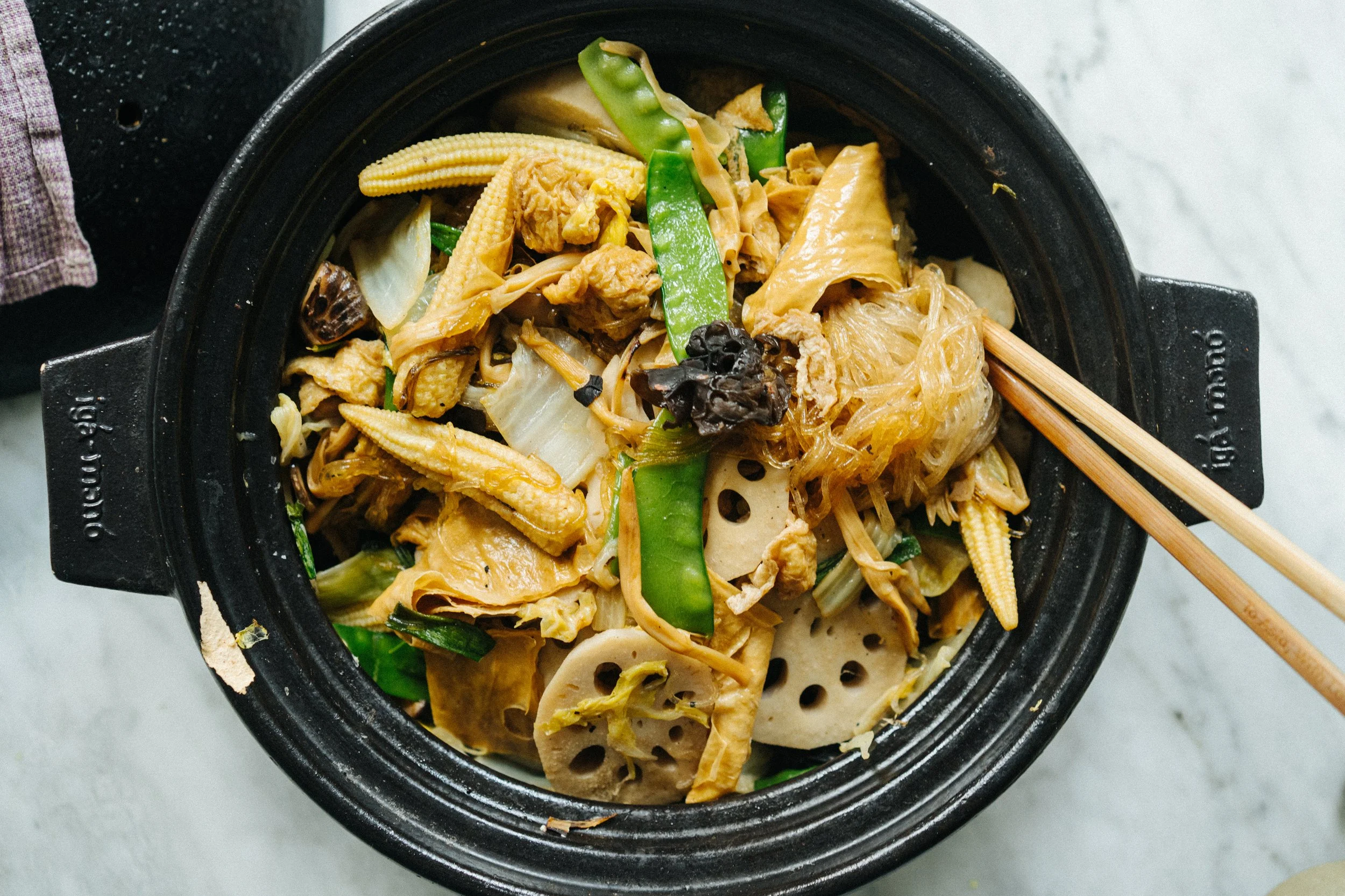Lo han Jai (Buddha’s delight)
Lo han Jai (Buddha’s delight)
This is an ESSENTIAL Lunar New Year recipe. Lo han jai, sometimes called Buddha’s Delight or Buddha’s Feast is the true HEART of our Cantonese Lunar New Year table. A dish with origins in Buddhist monk cuisine, it is vegan as many Buddhists observe the custom of not eating any meat on New Year’s Day (because meat involves killing and that is not auspicious on this day). My mother, who strictly observes this no-meat ritual, also makes lo han jai at many cultural celebrations including Ching Ming (Tomb Sweeping Day), Mid-Autumn Festival, and birthdays.
There is no single recipe for lo han jai. Like many traditional recipes, it is dependent upon both family customs and pantry ingredients. The key is bringing together ingredients with lots of different textures. While many of the ingredients may not look familiar, they are actually easily found at most Asian grocery stores.
Serves 4 - vegan, gluten free
Ingredients
- 1 tablespoon neutral oil
- 1 inch piece of ginger, peeled and sliced
- about 45g / 1.5 ounce (5-6 lumps) of red fermented bean curd (naam yu)*
- 4 green onions (scallions), white and green parts separated and cut into 2.5cm / 1-inch pieces
- 6 dried Chinese shiitake mushrooms, soaked in hot water for 30 minutes
- 8 black fungus, soaked in hot water for 30 minutes
- 20g dried lily flowers (optional), soaked in hot water for 30 minutes
- ½ teaspoon white sugar
- 50g dried tofu/beancurd skin, soaked in warm water for 30 minutes
- 60g fried tofu puffs
- 450g / 1 pound (¼ small) napa/chinese cabbage (wombok), cut into 5cm / 2-inch pieces
- 6-8 slices of fresh (or frozen) lotus root
- 2 tbsp soy sauce
- 1 cup mushroom soaking water or vegetable stock
- 1 tablespoon sesame oil
- white pepper
- 75g mung bean vermicelli noodles, soaked in warm water for 10 minutes
- 60g / 2 ounces snow peas or baby bok choy, trimmed
- 100g / 3.5 ounce canned baby corn
- 3 teaspoons sesame oil
- handful toasted sesame seeds
- cooked white or brown rice, to serve
If you can’t find naam yu (red fermented bean curd), substitute with fu yu (white fermented bean curd) or another fermented soy bean product - miso, Chinese fermented black soy beans or Doenjang.
Squeeze out the liquid from the mushrooms, cut off the stems (the stems are super chewy and I love them, so I add the stems to the dish but others discard) and slice; keep the mushroom soaking water for later. Drain the black fungus, trimming off any hard stems, and tear any large pieces in half. Drain the beancurd sticks and cut into 5cm (2 inch) pieces.
Heat a large Dutch oven or wide pot over medium-high heat. Add the oil and when hot, throw in the ginger and white part of the scallions and stir until fragrant, about 30 seconds. Reduce heat to medium, and add the red fermented beancurd, using a spoon or chopsticks to break it up. Add the mushrooms, black fungus, and lily buds, sugar, and a stir for 1-2 minutes. Next, add the cabbage, beancurd sticks, tofu puff, and lotus root and toss well for 1 minute. Add the soy sauce, mushroom soaking water or vegetable stock, and combine well. Cover and cook for 6-7 minutes until the cabbage has wilted.
Drain the mung bean vermicelli and add to the pot, along with the baby corn, snow peas, and green parts of the green onions and stir to combine. Cover and cook for 2-3 minutes, until the snow peas are bright green and crisp-tender and the vermicelli has expanded and soaked up some of the liquid. Drizzle over sesame oil, and taste, seasoning with salt, if required, and white pepper. Remove from heat immediately and scatter with a few sesame seeds. Serve hot, with rice.

